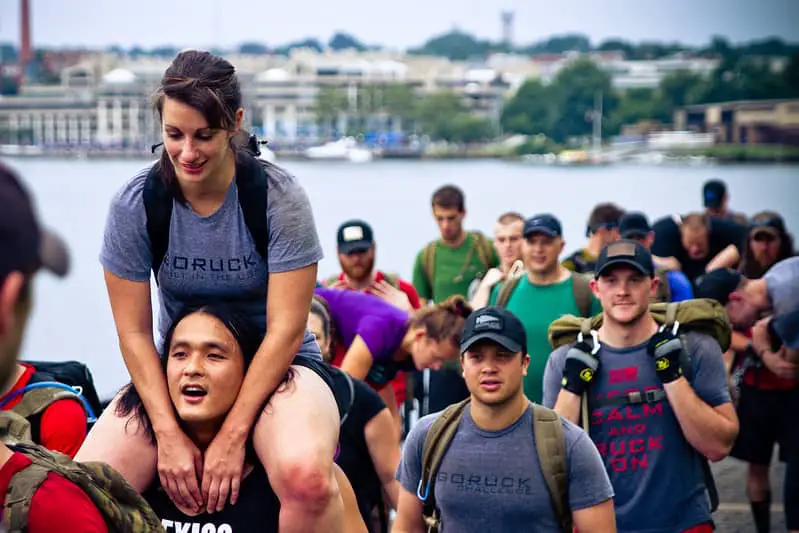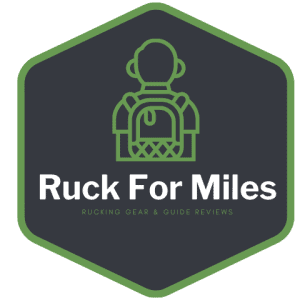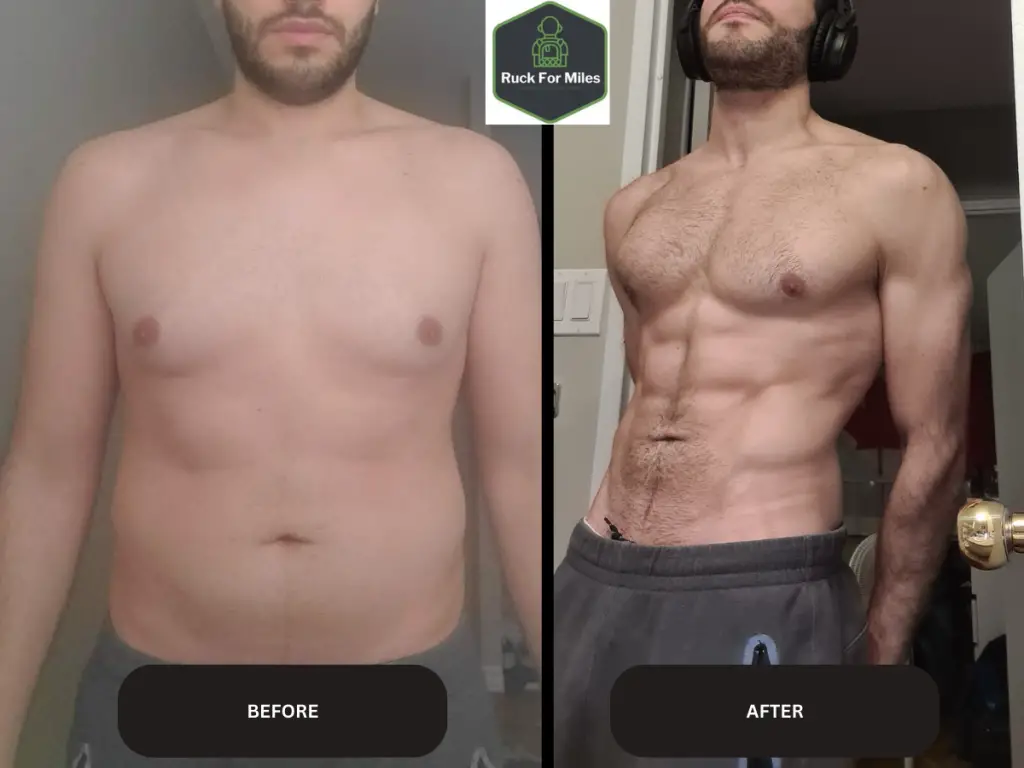Have you ever wondered if an unconventional fitness workouts like rucking could be the secret to building muscle?
In this post, I explore the dynamics of rucking. This article will unveil how rucking, the art of walking with added resistance, sets the stage for muscles to evolve, and whether it holds the potential to be your ally in the pursuit of a stronger physique.

Table of Contents:
1. How Does Building Muscle Work & How Rucking Helps
2. How Does Rucking Help with Building Muscle?
3. How Do You Accelerate Building Muscle Through Rucking?
4. Lower Body vs Upper Body Muscle Building Through Rucking
5. Building Muscle Through Rucking vs Traditional Weight Lifting
6. My Experience of Building Muscle Through Rucking
How Does Building Muscle Work & How Rucking Helps
The process of building muscle, whether it be through rucking or not, is simple. Building muscle, called hypertrophy, is a process where muscles experience stress and tiny damage when you do exercises that involve resistance, like lifting weights.
This stress tells your body to fix and rebuild the damaged parts of the muscles. This makes your muscles grow larger and stronger. Important things for muscle growth include gradually lifting heavier weights over time, eating well with enough protein, and giving your muscles time to recover through rest.
This is why you always see body builders drinking protein shakes and eating high amount of meat. Protein helps recover the muscle when it encounters stress and tiny tears or damage, it’s through this process that the muscle grows.
How Does Rucking Help with Building Muscle?
Rucking, a type of cardio workout where you walk with a backpack carrying extra weight, helps in building muscles by giving your body a steady and constant challenge. The weight in the backpack makes different muscle groups, like those in your legs, core, and upper body, work harder.
Rucking constantly encourages your muscles to get stronger over time. While it may not be as focused as typical strength training, rucking can still play a role in boosting muscle growth.
This is particularly true for people who want a workout that targets their whole body and improves their overall cardiovascular fitness.
How Do You Accelerate Building Muscle Through Rucking?
If you’re primary goal is to build muscle through rucking, do expect that your lower body (quads, hamstrings, calves) will see the most growth. Followed by your abs and back muscles as they suppors the weight carried in your backpack/rucksack.
If you’re looking to increase the speed of building muscle, consider implementing the following techniques:
- Ruck Uphill: Rucking on an incline will target your calves and will grow them if you’re training consistently.
- Ruck on different terrains: Mix up your rucking routine by rucking on different terrains, including uphill, downhill, and uneven surfaces. Switching up the landscape prompts different muscle groups to work in different ways, this shock and unexpected route will force your body to get out of its comfort zone and work harder which will force your muscles to grow.
- Progressive Distance: Gradually increase the distance of your rucks over time. Longer distances challenge your endurance and contribute to overall muscle development.
- Ruck Consistency: Make sure you’re sticking to a workout program or ruck a certain amount of times per week to see muscle growth
- Increase Weight Gradually: Make sure you’re aiming to increase your weight incrementally to see increased muscle growth rucking. Remember to make sure that you only increase the weight if you’re able to maintain proper form.
Summary:
To accelerate muscle building through rucking, consider uphill rucking, diverse terrain rucks, gradually extending distances, maintaining consistency, and incrementally increasing weight while ensuring proper form.
Lower Body vs Upper Body Muscle Building Through Rucking
Rucking is a whole body workout that will surely get you in shape. However, it tends to target your lower body muscles more than your upper body.
Lower Body Muscle Building Through Rucking
Rucking puts a significant emphasis on engaging the muscles of the lower body. As you walk with the weighted backpack, your legs, particularly the quadriceps, hamstrings, and calf muscles, are continuously working to lift your body and the added load.
The more the muscle is worked, the more it sustains stress and tiny muscle tears, which leads to muscle growth when these tears are recovered (eating a high protein diet helps recover the muscle and grow it accordingly).
Uphill rucking intensifies the effort, targeting your glutes and calves much more.
The repetitive motion of walking with resistance strengthens these muscles and contributes to their growth over time. Rucking on varying terrains adds diversity to lower body muscle engagement, promoting balanced development.
Summary:
Rucking engages lower body muscles, especially those in the legs, through the constant resistance provided by the weighted backpack.
Upper Body Muscle Building Through Rucking
While rucking predominantly focuses on the lower body, it also engages the upper body muscles to some extent.
The act of carrying the backpack and maintaining posture challenges your shoulder muscles, particularly the traps and deltoids.
However, the upper body engagement in rucking is generally not as intensive as traditional upper body exercises like weightlifting or bodyweight workouts.
To specifically target upper body muscle growth, incorporating additional upper body exercises into your fitness routine is recommended.
Summary:
While rucking involves some upper body muscles due to backpack carrying, it’s not as targeted as lower body engagement. For comprehensive upper body muscle development, supplement rucking with specific upper body exercises is recommended.
Building Muscle Through Rucking vs Traditional Weight Lifting
Rucking provides a comprehensive workout involving the entire body, with an emphasis on engaging the lower body and offering additional cardiovascular advantages.
It presents a distinct challenge through resistance and variation.
On the other hand, traditional weight lifting enables specific targeting of muscles, gradual increases in resistance, and concentrated muscle isolation to enhance strength and growth.
Choosing between them really depends on what your personal fitness goals are.
| Building Muscle Through Rucking | Building Muscle Through Traditional Weight Lifting |
|---|---|
| Compound Movement Training: Targets multiple muscle groups, with a primary focus on lower body. Involves upper body to a lesser extent. | Isolated Targeted Focus: Allows specific targeting of individual muscle groups using various exercises. |
| Resistance: Weight comes from the backpack, offering continuous challenge for muscle adaptation. | Progressive Loading: Provides precise control over resistance for gradual increases. |
| Cardio Component: Enhances endurance and overall fitness alongside muscle building. | Less Cardiovascular: Focuses primarily on muscular strength and growth. |
| Variability: Incorporates terrain changes for functional strength and balance. | Repetitive Movements: Primarily emphasizes muscle growth and size by repeating same exercises. |
My Experience of Building Muscle Through Rucking
I recently shared my experience on how I transformed my body through rucking. During my 8 months of dedicated focus on my fitness, I found myself solely relying on rucking in the first 3 months to get in shape.
However, as mentioned above, I found that my lower body was growing and seeing significant improvement while my upper body was lacking muscle development.
On the third month and beyond, I decided to include 2 classes of CrossFit a week to help me increase my upper body strength.
I found that through CrossFit, I was incorporating upper body exercise movements like Push-ups, Pull-ups, and core workouts that helped to accelerate my muscle growth.
In my opinion, and based on my personal experience, building muscle through rucking is great if you’re looking to improve your lower body strength, increase your endurance and cardio.
However if you’re looking to also build muscle in your upper body, I definitely recommend supplementing your rucking sessions with 1 or 2 upper body workouts in the gym for a more comprehensive workout.
Frequently Asked Questions
Does Rucking Give You Abs?
Yes, rucking can contribute to the development of abdominal muscles. However, it wont focus too much on growing them. Rucking will help your abs look more visible.
For more targeted and visible ab development, incorporating specific core exercises alongside rucking can yield better results. Check out the best exercises for rucking for workouts to supplement your rucks.
Does Rucking Build Your Traps?
Yes, rucking can help build the trap muscles, formally known as trapezius muscles. This is because when you carry a weighted backpack, your traps are engaged to support the load and maintain proper posture

